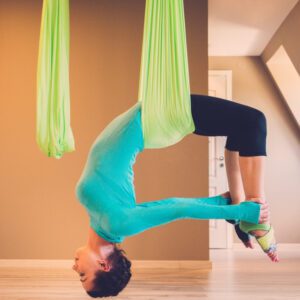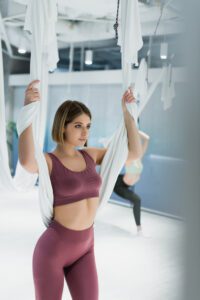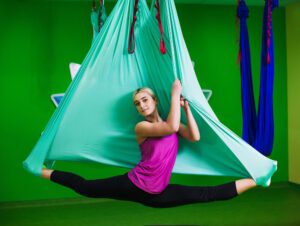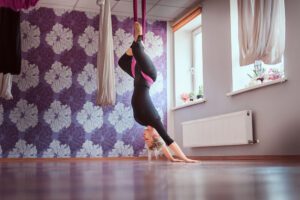 This article covers everything you need to know to do aerial yoga at home, including the equipment you will need, what to wear, and what to eat before a workout.
This article covers everything you need to know to do aerial yoga at home, including the equipment you will need, what to wear, and what to eat before a workout.
It also looks at the benefits and drawbacks of this popular practice, also known as anti-gravity yoga.
As its name suggests, aerial yoga is done in the air. Well, kind of!
Suspended yoga is a more apt term, as the postures and stretches are done with the assistance of a suspended hammock.
Some of the moves are performed upside down, which provides a greater challenge and range of movement than traditional yoga.
Table of Contents
Who will and won’t it suit?
Whether you are new to yoga or experienced, you can do aerial yoga at home if you have the proper equipment.
If you have joint issues, getting onto the floor can be challenging. Aerial yoga essentially eliminates this issue.
The suspended silk fabric and/or ropes reduce the load on wrists, knees, and hips, helping practitioners restricted due to joint problems implement poses.
Consult your doctor before undertaking anti-gravity yoga if you are pregnant, have heart disease, hypertension, or have had a hip replacement.
People with blocked sinus passages, vertigo, a detached retina, or cataracts should also consult a medical professional before doing aerial yoga.
You should also avoid it if you have a shoulder injury.
Aerial Yoga hammock Vs. swing and trapeze
You will need to buy an aerial yoga hammock, swing, or trapeze to do aerial yoga at home.
All are essentially the same thing. The only real difference is that hammocks are usually thicker, while swings and trapezes are thinner and have handles.
Space requirement
To do anti-gravity yoga at home, you will need a minimum ceiling height of approximately 9′, and 5″ of free space all around.
What does Aerial Yoga at Home Entail?
Whether you do aerial yoga at home or in a studio, it will involve traditional asanas (postures of yoga), yoga philosophy, and aerial art.
When performing poses, you will need to constantly engage your core muscles to maintain your balance and stability. As a result, your core and abs will quickly become strong and sculpted.
Focus is required, particularly for beginners mastering the poses and facing their fear of falling. This fear is unfounded.
While they may look delicate, the hammocks used in anti-gravity yoga are incredibly strong. They are able to withstand a load of many hundreds of pounds, so can fully support most people.
You can use them as a prop, wrapping them around specific body parts while keeping your feet, arms, buttocks, etc., on the floor. Or you can lie down in one, as you would in a regular hammock.
Hanging entirely or suspending individual body parts creates traction that allows your body to open more gently and intuitively than when doing the same moves on the floor.
The versatility and support of the fabric also provide access to movements not possible in traditional yoga.
Some aerial yoga classes have therapeutic purposes.
NB: Before doing aerial yoga at home, beginners should consult a qualified aerial yoga instructor on how to execute the poses correctly to prevent injury.
10-Minute Total Body Aerial Yoga Workout
Benefits of Anti-gravity Yoga
Whether doing aerial yoga at home or in a studio, it comes with many benefits, including the following:
Workouts are low-impact –
Workouts place almost zero pressure on the joints but are intense enough to burn 320 calories in 50 minutes.
It is easier to master than traditional yoga –
While some traditional yoga poses are easy to master, you can quickly become accomplished at doing advanced moves and inversions with aerial yoga.
Excellent upper body workout –
Pulling yourself onto your hammock requires strength, so done regularly, you will quickly be rocking sleeveless tops.
Strengthens and defines the core –
As well as being aesthetically pleasing, strong core muscles improve functional fitness, making it easier to perform everyday tasks.
Improves posture –
With a stronger core, your posture will be better, so you will look younger.
It may ease back pain –
Improved posture and the gentle stretching of aerial yoga may ease back pain in those who suffer it.
Decompresses joints –
Hanging in a yoga sling offers similar benefits to inversion therapy, decompressing joints that can compress over time due to gravity and aging.
Stimulates digestion –
The stretches involved in aerial yoga stimulate the digestive system, potentially providing relief from indigestion and constipation.
It may relieve stress and ease depression –
Traditional yoga is relaxing, and aerial yoga can be even more so.
In an American Council on Exercise (ACE) study, participants noted significantly lower stress levels and less depression following regular sessions.
Enhances balance, stability, and flexibility
Studies have found that people who regularly partake in aerial exercise have excellent balance, stability, and flexibility.
Reduces the risk of heart disease –
There’s limited research on the cardio benefits regular aerial yoga workouts provide. However, a 2016 (ACE) study found it significantly lowered the risk factors for heart disease.
The next section of this article discusses how to do aerial yoga at home.
Drawbacks of anti-gravity yoga
It’s intense –
While very gentle on the joints, aerial yoga workouts will intensely work your upper body, so be sure to warm up before your sessions to help prevent injury.
It requires concentration –
Concentration is required to maintain the proper form and stay safe – if you are looking for an activity that lets you zone out, this is not it.
It may not suit people with a fear of heights –
You won’t be far off the ground, but aerial yoga may not be for you if you fear heights.
Can take time to adapt –
When exercising upside down, blood will rush to your head. It may take time to get used to the feeling. Initially, you may even experience vertigo, but not everyone does.
How to do Aerial Yoga at home
It’s relatively easy to do anti-gravity yoga at home. Buying and setting up the equipment you will need is nowhere near as expensive or complicated as you may imagine. 
You can do the workouts indoors or outside. Either way, you will need access to solid support beams from which to hang your hammock.
If you don’t want to attach the equipment to your living room ceiling, your garage or basement, or even a door frame may be suitable.
A porch is a great option for outdoor workouts.
Alternatively, you can use an aerial yoga trapeze stand. This freestanding, portable piece of equipment will enable you to practice aerial yoga at home, anywhere you have the required space.
You will also be able to use the stand as a pull-up bar, for hanging a punching bag on, or as a regular hammock stand.
A porch is a great option for outdoor workouts.
If you want to exercise in your yard, you can use a sturdy tree branch, providing it’s the right height and has enough free space around it.
Setting up your hammock
Most yoga hammocks and swings come with installation instructions and the anchors, safety hooks, loop chains, etc., you will need.
Attach the fixtures, hang the hammock, so it is at waist height, then push down on it. If it is at hip height, you should be good to go. While this is the case with most hammocks, yours may differ, so refer to the instructions that came with it.
Safety Tips
It’s best to take down the hammock between workouts. It will be out of the way, and you will know the anchors are secure and the knots tight enough without having to remember to check before working out.
If you use the hammock outdoors, an additional benefit to taking it down between sessions is that its fabric won’t be exposed to the elements, so it won’t wear as quickly.
If the fabric frays or rips, it will no longer be able to bear as much weight.
NB: Regularly check that the anchors, hooks, and loops are secure before working out.
If you’re not sure how strong the beams in your home are, check with a builder before installing your hammock.
Should I eat before an aerial yoga workout?
Doing aerial yoga workouts on an empty stomach can lead to dizziness, so eat something.
Having anything heavy or greasy within the hour before your workout could result in bloating and nausea.
Steer clear of carb-dense foods that could weigh you down.
You should also avoid acidic foods and drinks before doing aerial yoga, as these could give you a stomach upset.
Dairy products can cause bloating, gas, and diarrhea.
Your best bet is to have a light, easily digestible, energy-producing snack.
Some good options include a banana, a small handful of almonds, some oatmeal, or a green smoothie.
Clothing requirements
Clothing requirements are similar, whether doing aerial yoga at home or in a studio.
The hammock’s ropes and silk can rub against and irritate or chafe the skin, so wear well-fitting, comfortable activewear with decent coverage and a sports bra.
You will want to do this anyway. Remember, you will be upside down for some of the moves, and the last thing you need is the distraction of a wardrobe malfunction.
Leggings or fitted yoga pants and a comfortable, non-restrictive fitted top are ideal.
There’s nothing to stop you from wearing shorts, but as mentioned above, it’s best to cover any body parts the ropes and silk could irritate. This includes the back of your knees, so long pants are best.
For the same reason, I recommend wearing a long-sleeved top with enough length to cover your lower back and abdomen. Long sleeves will also protect the sensitive underarm area.
You can go barefoot if desired, but I recommend wearing yoga or grippy socks. Socks will protect your feet from fabric burn as you mount or swing on the hammock.
Is there anything else I should know?
There’s nothing more annoying than hanging upside down with hair in your face. So tie your hair back if it is long, or wear a headband if it is long enough to get in your eyes.
It’s a good idea to remove your jewelry before exercising as it could catch on and snag the hammock or swing.
Go easy on perfume, potions, and lotion.
Perfume and essential oil scents often become more potent when combined with heat and sweat. The resulting smell can be unpleasant or sickly and linger on the hammock.
Hand and body lotion or oil can affect grip, so it’s best not to use them before aerial yoga sessions.
When doing aerial yoga in a studio, take a towel. Some studios supply one, but you may prefer to use your own.
Final Thoughts on doing Aerial Yoga at Home
Aerial yoga is exhilarating and effective, and it offers numerous valuable benefits.
Being low-impact, the risk of injury is low, and almost anyone can do it. (Please read “who will and won’t it suit” above.)
Regular workouts will relieve stress, improve your balance and flexibility, and ease stress. It’s also one of the best upper body and core workouts you can do.
I recommend that you initially take some classes. If you like it – and most people do – buy your own equipment, and you will be able to do aerial yoga at home whenever the mood strikes.

